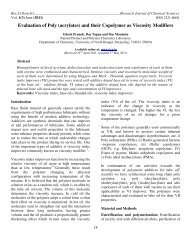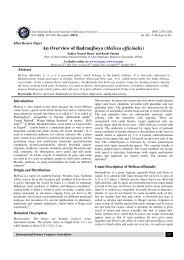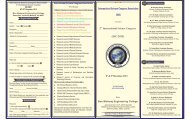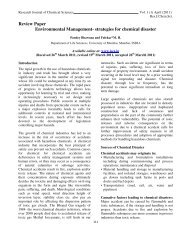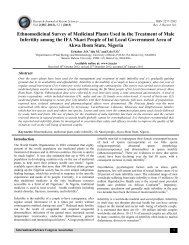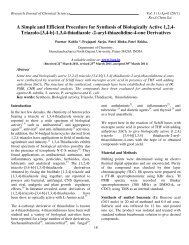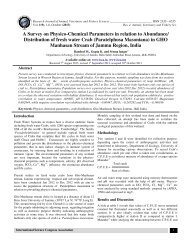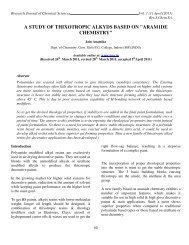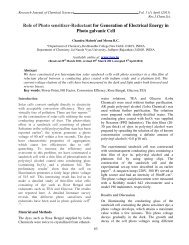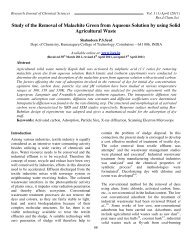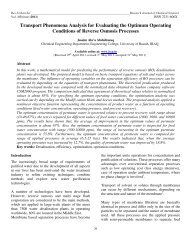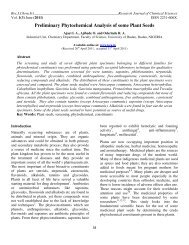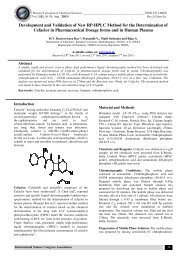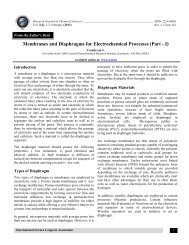Design and development of fast Melting Tablets of ... - ISCA
Design and development of fast Melting Tablets of ... - ISCA
Design and development of fast Melting Tablets of ... - ISCA
You also want an ePaper? Increase the reach of your titles
YUMPU automatically turns print PDFs into web optimized ePapers that Google loves.
Research Journal <strong>of</strong> Chemical Sciences Vol. 1 (1) April (2011)<br />
Res.J.Chem.Sci.<br />
<strong>Design</strong> <strong>and</strong> <strong>development</strong> <strong>of</strong> <strong>fast</strong> <strong>Melting</strong> <strong>Tablets</strong> <strong>of</strong> Terbutaline Sulphate<br />
Mathew T <strong>and</strong> Agrawal S<br />
Swami Vivekan<strong>and</strong> College <strong>of</strong> Pharmacy, Kh<strong>and</strong>wa Road, Indore (MP), INDIA<br />
Available online at: www.isca.in<br />
(Received 5 th April 2011, revised 7 th April 2011, accepted 9 th April 2011)<br />
Abstract<br />
Difficulty in swallowing leads to non-compliance <strong>and</strong> subsequently leading to ineffective therapy.<br />
Terbutaline Sulphate is a beta-2 agonist <strong>and</strong> has action similar to that <strong>of</strong> Isoproterenol. The basic<br />
aim <strong>of</strong> this formulation was to decrease the onset time <strong>of</strong> the drug by decreasing the disintegration<br />
time <strong>of</strong> the tablet by formulating <strong>fast</strong> melting tablet. In the present study <strong>fast</strong> melting tablets <strong>of</strong><br />
Terbutaline Sulphate was prepared by using <strong>of</strong> superdisintegrants. The tablets were prepared by<br />
direct compression technique. Six formulations <strong>of</strong> tablets were prepared containing drug. Prepared<br />
tablets were evaluated on different parameters. Evaluation results shows tablet to be within the<br />
<strong>of</strong>ficial limits. Wetting time <strong>and</strong> disintegration were in limits that are prescribed for mouth dissolving<br />
tablets. Dissolution pr<strong>of</strong>ile <strong>of</strong> the tablet shows that the excipients used in the tablet had no negative<br />
influence on the release pattern <strong>of</strong> the drug. It was thus possible to formulate mouth melting tablets <strong>of</strong><br />
Terbutaline Sulphate using simple <strong>and</strong> cost effective technique.<br />
Key words: Terbutaline Sulphate, direct compression, super disintegrant.<br />
Introduction<br />
In today’s world when air pollution is rampant<br />
people <strong>of</strong> all ages <strong>and</strong> classes are vulnerable to<br />
diseases related to respiratory system. Asthma is<br />
one such common disease <strong>of</strong> the respiratory system<br />
to have a big influence on human race. This disease<br />
affects people <strong>of</strong> all age; young or old all alike.<br />
This disease is caused by the constriction <strong>of</strong> the<br />
airways particularly bronchi. Terbutaline Sulphate<br />
is a selective beta -2 adrenoreceptor agonist <strong>and</strong><br />
used in acute treatment <strong>of</strong> bronchial asthma since it<br />
help in dilating the constricted bronchi, Terbutaline<br />
sulphate is used in various other forms <strong>of</strong> chronic<br />
obstructive pulmonary diseases. Terbutaline<br />
sulphate is a short acting bronchorelaxant <strong>and</strong> is<br />
given in all the major routes <strong>of</strong> administration. The<br />
peak plasma concentration <strong>of</strong> Terbutaline sulphate<br />
is 1.2µg/ml for every milligram <strong>of</strong> oral dose. A<br />
lesser amount than that <strong>of</strong> oral administration<br />
reaches the systemic circulation via inhalation<br />
route, since it is difficult to coordinate the<br />
breathing when the pump is pressed; this creates<br />
problems in the treatment <strong>of</strong> the patient. Also<br />
pumps are expensive as compared to solid oral<br />
dosage form 1,2 .<br />
105<br />
105<br />
In-spite <strong>of</strong> innumerable advancement in the dosage<br />
form technology solid oral dosage remains among<br />
the most favoured option by patients due to reasons<br />
like easy to h<strong>and</strong>le, cost effective, no dose<br />
variation associated with solid orals, ease <strong>of</strong><br />
storage 3 . Although solid orals come with these<br />
advantages but there is a drawback associated with<br />
them. Many patients particularly paediatric <strong>and</strong><br />
geriatric find it difficult to swallow solid oral<br />
dosage form like tablets <strong>and</strong> capsules 4 , owing to<br />
which patients do not stick to the dosage regimen<br />
prescribed by the physician resulting in incomplete<br />
dose reaching the systemic circulation <strong>and</strong> leads to<br />
resistance <strong>development</strong> in case <strong>of</strong> antibiotics <strong>and</strong><br />
similar disadvantages with other classes <strong>of</strong> active<br />
moieties.<br />
Recent advancement in novel drug delivery<br />
systems aims to enhance the safety <strong>and</strong> efficacy <strong>of</strong><br />
the drug molecule <strong>and</strong> decrease the problems<br />
associated to the conventional dosage form. One<br />
such novel dosage form for drug delivery is <strong>fast</strong><br />
melting tablets which are more commonly known<br />
as oral disintegrating tablets. The proper choice <strong>of</strong><br />
disintegrants <strong>and</strong> the optimum concentration <strong>of</strong> the<br />
same is critical factor in the design <strong>and</strong><br />
<strong>development</strong> <strong>of</strong> <strong>fast</strong> melting tablets. These super
Research Journal <strong>of</strong> Chemical Sciences Vol. 1 (1) April (2011)<br />
Res.J.Chem.Sci.<br />
disintegrants are polymers which are cross linked Compression force was kept constant for all<br />
<strong>and</strong> have the capability to swell in contact with formulations.<br />
aqueous medium. As the superdisintegrants swell<br />
they increase the diameter <strong>of</strong> the tablet <strong>and</strong> help in Evaluation <strong>of</strong> powder blend<br />
overcoming the binding force <strong>of</strong> the binder <strong>and</strong> the Angle <strong>of</strong> repose: The angle <strong>of</strong> repose <strong>of</strong> powder<br />
compaction force used in the formulation <strong>of</strong> the blend was determined by the funnel method 5 .<br />
tablet which held together the granules.<br />
Results are shown in table 3.<br />
In this work we have tried to formulate a mouth<br />
melting dosage form <strong>of</strong> Terbutaline Sulphate by<br />
varying the concentration <strong>of</strong> superdisintegrants<br />
[Crospovidone (CP) <strong>and</strong> Croscarmellose Sodium<br />
(CCS)] so as to know at which concentration it is<br />
most effective.<br />
Materials <strong>and</strong> Methods<br />
Terbutaline Sulphate was obtained as a gift sample<br />
from IPCA laboratories Pvt. Ltd. Ratlam, India.<br />
Croscarmellose Sodium <strong>and</strong> Crospovidone were<br />
obtained as gift samples from Syncom labs. Pvt.<br />
Ltd. All other chemicals were <strong>of</strong> analytical grade.<br />
Optimisation <strong>of</strong> Superdisintegrant<br />
concentration: Before the formulation <strong>of</strong> Fast<br />
melting tablet the amount <strong>of</strong> CP <strong>and</strong> CCS was<br />
optimised. Various batches <strong>of</strong> tablets were<br />
prepared containing blend <strong>of</strong> Mannitol <strong>and</strong> CP or<br />
CCS in varying concentration. The weight <strong>of</strong> tablet<br />
was fixed at 150 mg. All the tablets were prepared<br />
using direct compression method. All the<br />
formulation variables were held constant in order<br />
to optimise the amount <strong>of</strong> CP <strong>and</strong> CCS. The data<br />
displayed in table 1.<br />
Preparation <strong>of</strong> <strong>fast</strong> melting tablets: Fast<br />
melting tablets <strong>of</strong> batch size five hundred (500)<br />
was prepared by direct compression process using<br />
different proportions <strong>of</strong> Mannitol <strong>and</strong> CP or CCS.<br />
Mannitol, CP or CCS to be used in each batch <strong>and</strong><br />
Terbutaline Sulphate were mixed thoroughly for 15<br />
minutes in a porcelain mortar <strong>and</strong> passed through<br />
sieve # 60. This blend was mixed with aerosil, pregelatinised<br />
starch, <strong>and</strong> magnesium separate<br />
(magnesium separate was added in last as it is<br />
hydrophobic in nature <strong>and</strong> affects tablet<br />
disintegration) for five minutes <strong>and</strong> again the entire<br />
blend was passed through sieve # 80. Powder<br />
blend was evaluated for bulk density, tapped<br />
density, Carr’s index <strong>and</strong> Hauser’s ratio.<br />
Compression <strong>of</strong> tablets was done on single punch<br />
machine (Scientech) using 7 mm flat punch.<br />
106 107<br />
Bulk density <strong>and</strong> Tapped density: Powder bulk<br />
density <strong>and</strong> tapped density were determined using<br />
the usual process 5 . Results are displayed in table 3<br />
Carr’s Index: Carr’s Index was determined by<br />
using the under mentioned formula 5 .<br />
Carr’s Index (%) = [(TD-BD) x100]/TD<br />
Where<br />
TD- tapped density<br />
BD- bulk density<br />
table 3 shows results<br />
Hausner’s Ratio: Hausner’s ratio was determined<br />
by the underlying formula 5 .<br />
Where<br />
H = P T /P B<br />
H denotes Hausner’s ratio<br />
P T denotes tapped density<br />
<strong>and</strong> P B denotes bulk density<br />
Results are shown in table 3<br />
Evaluation <strong>of</strong> Tablet Characteristics<br />
Hardness test <strong>and</strong> Friability: Hardness <strong>of</strong> tablet<br />
was evaluated using Monsanto hardness tester 6 .<br />
Friability <strong>of</strong> tablets was tested by Roche’s<br />
friabilator 6 .<br />
Drug Content: Drug content <strong>of</strong> prepared tablet <strong>of</strong><br />
each batch <strong>of</strong> the formulation was determined 8 .<br />
From each batch 20 tablets were taken, weighted<br />
<strong>and</strong> finely grounded. An amount <strong>of</strong> powder<br />
equivalent to 5 mg <strong>of</strong> powder was accurately<br />
weighted <strong>and</strong> dissolved in 6.8 phosphate buffer.<br />
The resulting solution was suitably diluted <strong>and</strong><br />
analysed on UV spectrophotometer Shimadzu 1601<br />
at 284 nm.<br />
Weight Variation: Weight variation 6 was<br />
determined by taking 20 tablets using electronic<br />
balance (Contech).
Research Journal <strong>of</strong> Chemical Sciences Vol. 1 (1) April (2011)<br />
Res.J.Chem.Sci.<br />
Wetting time: A double folded absorbent paper 7<br />
was kept on petridish <strong>and</strong> thoroughly wetted with<br />
distilled water. Excess distilled water was drained<br />
out <strong>of</strong> the petridish. Tablet was placed at the centre<br />
<strong>of</strong> the wet absorbent paper. The time required for<br />
the water to diffuse from the absorbent paper<br />
throughout the entire tablet was recorded using<br />
stopwatch. This test was performed thrice (n = 3).<br />
This method will duplicate the in-vivo<br />
disintegration <strong>of</strong> tablet kept on tongue. Lesser is<br />
the disintegration time more porous is the tablet.<br />
Disintegration test: Disintegration test was<br />
measured using disintegration test apparatus. One<br />
tablet was placed in each <strong>of</strong> the six tubes <strong>of</strong><br />
disintegration test apparatus. I.P. method was<br />
followed without using disc 8 . The time required for<br />
complete disintegration <strong>of</strong> tablet in each tube was<br />
determined using stop watch.<br />
In –vitro Dissolution rate study: Dissolution test<br />
<strong>of</strong> Terbutaline Sulphate was performed in 6.8<br />
phosphate buffer at 50 rpm using USP dissolution<br />
test apparatus type II (paddle type) 9,10 . Five ml<br />
aliquots were withdrawn with a pipette <strong>and</strong><br />
replaced with 5 ml fresh dissolution medium at an<br />
interval <strong>of</strong> 1 minute. The aliquots were passed<br />
through Whatman filter paper number 41 to<br />
remove any suspended impurity which may<br />
interfere during spectroscopic estimation. The<br />
absorbance <strong>of</strong> samples was taken on UV<br />
spectrophotometer (Shimadzu 1601) at 284 nm<br />
against blank <strong>and</strong> correspondingly concentration <strong>of</strong><br />
the drug was determined at various time intervals.<br />
Result <strong>and</strong> Discussion<br />
The pre-compression parameters <strong>of</strong> the powder<br />
blend were evaluated <strong>and</strong> batch F4 was found to<br />
have angle <strong>of</strong> repose value 24°.36' indicating<br />
excellent flow. Formulation F3 had the highest<br />
value <strong>of</strong> angle <strong>of</strong> repose suggesting comparatively<br />
poor flow. The other evaluation parameters <strong>of</strong><br />
powder blend namely Carr’s index for all the<br />
formulations showed values in range <strong>of</strong> 7.70% to<br />
13.53% indicating good flow property; similarly<br />
Hausner’s ratio values for all the formulations lied<br />
in the range <strong>of</strong> 1.086 to 1.156. The values obtained<br />
for Hausner’s ratio indicate good flowability.<br />
Table3 shows the results for powder blend<br />
characterisation.<br />
107 108<br />
The additives used in the formulation did not<br />
interfered with the UV absorption <strong>of</strong> Terbutaline<br />
sulphate <strong>and</strong> there was no interaction between drug<br />
<strong>and</strong> the excipients as per the physical observation<br />
<strong>of</strong> the mixture <strong>of</strong> drug <strong>and</strong> excipients in 1:1 ratio.<br />
From the data obtained from the optimisation <strong>of</strong><br />
the formulation the amount <strong>of</strong> superdisintegrants<br />
were varied from 2.66%w/w to 6.66% w/w<br />
keeping in mind the optimisation between the<br />
disintegration time <strong>and</strong> final cost <strong>of</strong> the tablet.<br />
Correspondingly amount <strong>of</strong> mannitol was varied to<br />
maintain the final weight <strong>of</strong> the tablet. The amount<br />
<strong>of</strong> CP <strong>and</strong> CCS containing 6.66% w/w <strong>of</strong><br />
superdisintegrants produced optimum result<br />
Fast melting tablet <strong>of</strong> Terbutaline sulphate was<br />
being formulated successfully by use <strong>of</strong> direct<br />
compression technique. Formulation F4 was found<br />
to have best disintegration time <strong>of</strong> 52 seconds<br />
under experimental conditions at room<br />
temperature. Concentration dependent<br />
disintegration <strong>of</strong> the tablet was seen in the results.<br />
As the amount <strong>of</strong> disintegrant was increased the<br />
time required for the disintegration <strong>of</strong> tablets were<br />
reduced. The water uptake by the polymers (CP<br />
<strong>and</strong> CCS) <strong>and</strong> corresponding swelling resulted in<br />
the bursting <strong>of</strong> the tablet structure. The swelling<br />
force acted against the binding force in order to<br />
break apart the tablet.<br />
Wetting time <strong>of</strong> the various different formulations<br />
was found to be in the range <strong>of</strong> 49-70 seconds.<br />
Formulation F4 containing CP had lowest wetting<br />
time <strong>of</strong> 49 sec; this may be due to the better<br />
wicking action produced by the polymer.<br />
Conclusion<br />
The aim <strong>of</strong> <strong>development</strong> <strong>of</strong> <strong>fast</strong> melting tablets <strong>of</strong><br />
Terbutaline sulphate by direct compression<br />
technique was achieved. This formulation is more<br />
cost effective than aerosol inhalation pumps<br />
available. It was found that the total amount <strong>of</strong><br />
drug from the optimised batch was released in first<br />
4 minutes <strong>of</strong> the dissolution study. The tablets<br />
disintegrated within 50 sec under experimental in<br />
vitro laboratory conditions.
Research Journal <strong>of</strong> Chemical Sciences Vol. 1 (1) April (2011)<br />
Res.J.Chem.Sci.<br />
References<br />
5. Indian Pharmacopoeia. Controller <strong>of</strong> publication,<br />
1. T.M, Pramod K., Shivakumar H.G., Novel core<br />
Govt. <strong>of</strong> India New Delhi, 4 edition, volume 2, 735<br />
in cup buccoadhesive system <strong>and</strong> films <strong>of</strong><br />
(1996).<br />
Terbutaline Sulphate – <strong>development</strong> <strong>and</strong> in vitro<br />
evaluation, Asian Journal <strong>of</strong> pharmaceutical<br />
6. Mahapatra A.K, Murthy P.N, Sahoo J, et al<br />
Science, 175-187 (2006).<br />
2. Karabey Y, Sahin S, Oner L, Hinchal A.A,<br />
Bioavailability file: Terbutaline, FABAD<br />
J.Pharm.Sci., 28, 149-160, (2003).<br />
3. Indurvade N.H, Rajayaguru T.N, Nakhat P.D.<br />
Novel approaches-Fast dissolving tablet. Indian<br />
Drugs, 39, 405-409, (2002).<br />
3. Schmidth P.C, Schiemeier S, Fast dispersible<br />
Ibupr<strong>of</strong>en tablet, European J. Pharm. Sciences, 15,<br />
295-305, (2002).<br />
4. Lachmann, L, Lieberman H.A, Kiang J.L, The<br />
Theory <strong>and</strong> Practice <strong>of</strong> Industrial Pharmacy.<br />
Varghese publishing House Bombay, 3 rd ed, 66-<br />
99, (1971).<br />
Formulation design <strong>and</strong> optimisation <strong>of</strong> mouth<br />
dissolving tablets <strong>of</strong> Levocertirizine Hydrochloride<br />
using sublimation technique, 43(1), 39-45, (2009).<br />
7. Indian Pharmacopoeia, Controller <strong>of</strong> publication,<br />
Govt <strong>of</strong> India, Edition 4, Volume 2, 736 (1996).<br />
8. The United States Pharmacopoeial Convention,<br />
“The United States Pharmacopoeia, 30 NF25,<br />
Rockville MD (2000).<br />
9. Sinko P.J. Dissolution <strong>and</strong> release from oral<br />
drug products, Martin’s physical pharmacy <strong>and</strong><br />
pharmaceutical sciences, 5 edition Lippincott<br />
Williams <strong>and</strong> Wilkins, 337-354, (2006).<br />
Table-1: Formula for different batches <strong>of</strong> Fast melting tablets <strong>of</strong> Terbutaline sulphate<br />
Batch Superdisintegrant Superdisintegrant<br />
(%w/w)<br />
Disintegration Time<br />
(Sec)<br />
A1 CCS 1.33 138<br />
A2 CCS 2.66 80<br />
A3 CCS 5.33 76<br />
A4 CCS 6.66 60<br />
A5 CCS 8.00 55<br />
A6 CP 1.33 125<br />
A7 CP 2.66 76<br />
A8 CP 5.33 69<br />
A9 CP 6.66 56<br />
A10 CP 8.00 50<br />
CP- Crospovidone; CCS- Croscarmellose Sodium<br />
108 109
Research Journal <strong>of</strong> Chemical Sciences Vol. 1 (1) April (2011)<br />
Res.J.Chem.Sci.<br />
Table-2: Formula for different batches <strong>of</strong> Fast melting tablets <strong>of</strong> Terbutaline sulphate<br />
Ingredients F1 F2 F3 F4 F5 F6<br />
Terbutaline Sulphate 5 5 5 5 5 5<br />
Mannitol 127.0 130.0 133.0 127.0 130.0 133.0<br />
Croscarmellose sodium 10.0 7.0 4.0 - - -<br />
Crospovidone - - - 10.0 7.0 4.0<br />
Aerosil 3.0 3.0 3.0 3.0 3.0 3.0<br />
Pre-gelatinised Starch 2.0 2.0 2.0 2.0 2.0 2.0<br />
Menthol 1.0 1.0 1.0 1.0 1.0 1.0<br />
Magnesium stearate 1.0 1.0 1.0 1.0 1.0 1.0<br />
Table-3: Pre compressed parameter <strong>of</strong> powder blend for Fast melting tablets <strong>of</strong> Terbutaline Sulphate<br />
Powder<br />
Angle <strong>of</strong><br />
Bulk Density<br />
Tapped Density<br />
Carr’s Index<br />
Hausner’s<br />
blend<br />
Repose ( 0 ) (n=3)<br />
(g/cm 3 ) (n=3)<br />
(g/cm 3 ) (n=3)<br />
(%)<br />
ratio<br />
F1 27°.30' 0.527 0.571 7.70 1.083<br />
F2 27°.54' 0. 523 0.575 9.04 1.099<br />
F3 27°.64' 0. 520 0.573 9.24 1.101<br />
F4 24°.36' 0. 516 0.583 11.49 1.129<br />
F5 24°. 43 ' 0. 514 0.588 12.58 1.143<br />
F6 24°.45' 0. 511 0.591 13.53 1.156<br />
109 107
Research Journal <strong>of</strong> Chemical Sciences<br />
Batches<br />
Table-4: Physical parameters <strong>of</strong> Fast melting tablets <strong>of</strong> Terbutaline Sulphate<br />
Thickness<br />
(mm)<br />
n = 3<br />
Hardness<br />
(Kg/cm 2 )<br />
n = 3<br />
F1 2.7 ±0.1 2.43<br />
F2 2.8 ±0.1 2.45<br />
F3 2.7±0.1 2.41<br />
F4 2.9±0.1 2.42<br />
F5 3.0±0.1 2.45<br />
F6 3.5±0.1 2.50<br />
Friabilit<br />
y (%)<br />
n = 3<br />
0.51 ±<br />
0.1<br />
0.56 ±<br />
0.1<br />
0.54 ±<br />
0.1<br />
0.51 ±<br />
0.1<br />
0.51 ±<br />
0.1<br />
0.50 ±<br />
0.1<br />
Weight<br />
Variatio<br />
n (mg)<br />
n = 3<br />
Wetting<br />
time<br />
(sec)<br />
Disintegratio<br />
n time (sec)<br />
150.15 52 59<br />
151.5 59 68<br />
151.1 70 75<br />
149.5 49 52<br />
152.0 55 64<br />
155.11 56 63<br />
Figure-1: Drug release pr<strong>of</strong>ile <strong>of</strong> Fast melting tablet <strong>of</strong> Terbutaline Sulphate<br />
Vol. 1 (1) April (2011)<br />
Res.J.Chem.Sci.<br />
Drug content<br />
uniformity<br />
(%)<br />
98.97<br />
98.95<br />
98.76<br />
99.81<br />
98.69<br />
98.95<br />
120<br />
% cumulative drug relese v/s time for <strong>fast</strong> melting tablet <strong>of</strong> terbutaline<br />
Sulphate<br />
% cumulative release <strong>of</strong> terbutaline sulphate from formulation<br />
100<br />
80<br />
60<br />
40<br />
20<br />
0<br />
0 1 2<br />
3 4 5<br />
F1<br />
F2<br />
F3<br />
F4<br />
F5<br />
F6<br />
Time in min<br />
110 108



